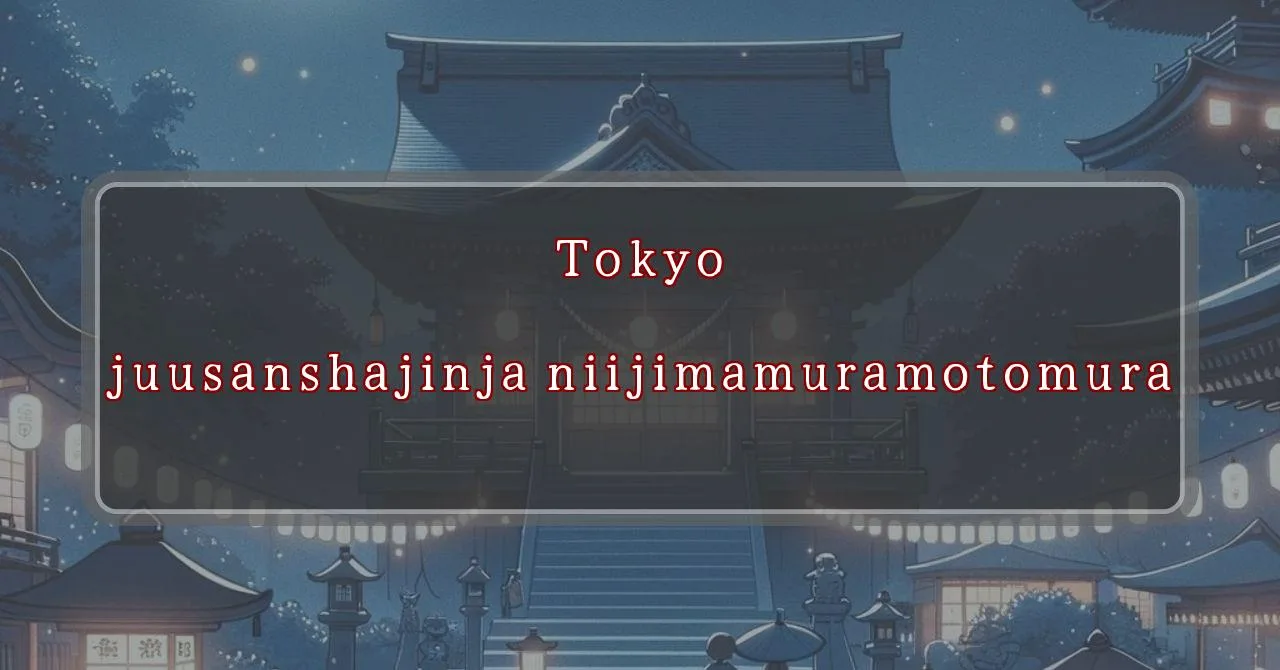A sacred festival of lights and music in Shinto shrine
Basic Information
Jusanja Shrine is a Shinto shrine located in the village of Niijima, Tokyo. It is dedicated to thirteen deities, including Kotosironushi no Mikoto, the god of agriculture, industry, and commerce.
- Address: 2-6-13 Moto-mura, Niijima-mura, Tokyo 100-0402
- Phone Number: 04992-5-1870
- Access: Take a 10-minute walk from Niijima Port.
- Festival Days: December 8th, 2024
Main Events and Attractions of the Festival
The Jusanja Shrine Festival is a vibrant and colorful celebration that attracts visitors from all over the region. The main events and attractions of the festival include:
Mikoshi Procession
A highlight of the festival is the mikoshi procession, where a portable shrine is carried through the streets of Niijima village. The mikoshi is decorated with elaborate carvings and ornaments, and it is believed to be inhabited by the spirits of the thirteen deities enshrined at Jusanja Shrine.
Kagura Performance
Kagura is a traditional Japanese dance and music performance that is often performed at Shinto festivals. At the Jusanja Shrine Festival, kagura is performed by local dancers and musicians, and it tells the stories of the thirteen deities and their connection to the island of Niijima.
獅子舞 (Lion Dance)
The lion dance is a popular attraction at many Japanese festivals, and the Jusanja Shrine Festival is no exception. The lion dance is performed by two dancers, one wearing a lion head and the other wearing a lion body. The lion dances to the beat of drums and gongs, and it is believed to bring good luck and ward off evil spirits.
Food and Games
No Japanese festival is complete without food and games! At the Jusanja Shrine Festival, there are many food stalls selling a variety of traditional Japanese dishes, as well as games and activities for children and adults alike.
Blessings and Deities
Jusanja Shrine is dedicated to thirteen deities, collectively known as the Jusanja Daimyojin. These deities are believed to bring blessings and protection to the people of Niijima and the surrounding area. Some of the deities enshrined at Jusanja Shrine include:
- Kotosironushi no Mikoto: The god of agriculture, industry, and commerce
- Oyamatohime no Mikoto: The goddess of marriage and childbirth
- Susanoo no Mikoto: The god of the sea and storms
- Inari no Kami: The god of rice and fertility
- Ebisu no Kami: The god of fishing and wealth
Origin and History
The origins of Jusanja Shrine are unclear, but it is believed to have been founded in the 13th century. The shrine was originally located on the coast of Niijima, but it was moved to its current location in the 17th century after a tsunami destroyed the original shrine.
Jusanja Shrine has long been an important religious center for the people of Niijima. The shrine is dedicated to thirteen deities, who are believed to bring blessings and protection to the island and its inhabitants. The shrine is also a popular tourist destination, and it attracts visitors from all over Japan and the world.
Tips and Notes for Visitors
If you are planning to visit Jusanja Shrine during the festival, here are a few tips and notes to keep in mind:
- The festival is held on December 8th every year.
- The festival is a popular event, so it is important to arrive early to avoid crowds.
- There is a large parking lot near the shrine, but it can fill up quickly. If you are driving, it is best to arrive early or park in a nearby parking lot and walk to the shrine.
- The festival is a great opportunity to experience Japanese culture and traditions. There are many food stalls selling traditional Japanese dishes, as well as games and activities for children and adults alike.
- The shrine is also a popular spot for weddings and other special events.
Parking Information
There is a large parking lot near Jusanja Shrine, but it can fill up quickly during the festival. If you are driving, it is best to arrive early or park in a nearby parking lot and walk to the shrine.
Here are some nearby parking lots that you can use:
- Niijima Village Hall Parking Lot
- Niijima Elementary School Parking Lot
- Niijima Junior High School Parking Lot
Popular Stalls and Food Carts in Recent Years
| Type of Stall | Description |
|---|---|
| Takoyaki | A staple at Japanese festivals. Characterized by a crispy outside and a creamy inside. |
| Jaga Butter | A simple yet popular snack of hot potatoes lavishly topped with melted butter. |
| Baby Castella | Small castella cakes, sweet and fluffy treats enjoyed by children and adults alike. |
| Grilled Ayu with Salt | Fresh ayu fish grilled whole with salt, a savory taste of Japanese summer. |
| Shaapin | A unique gourmet item influenced by foreign cuisine, with a chewy skin wrapping the filling. |
| Okonomiyaki | A Japanese grilled dish where you often choose your own ingredients for a personalized flavor. |
| Cotton Candy | A fluffy, sweet snack that’s extremely popular with children. |
| Chocolate Banana | A banana coated in chocolate, a fun and visually appealing dessert. |
| Kushiyaki | Various types of ingredients skewered and grilled, an easy-to-enjoy snack. |
| Yakisoba | Fried noodles mixed with a special sauce, a fast food favorite in Japan. |



